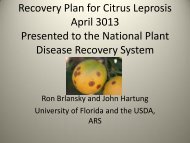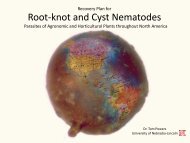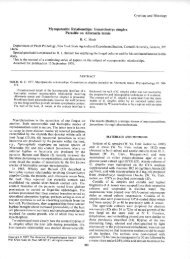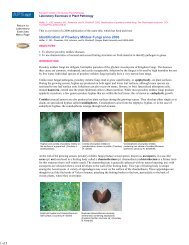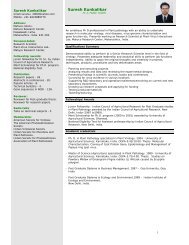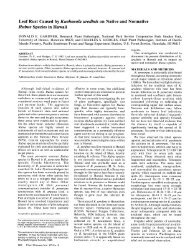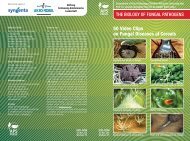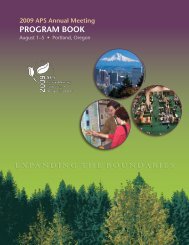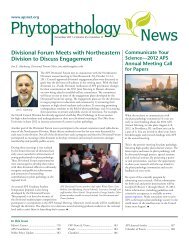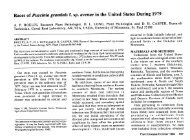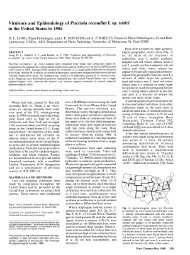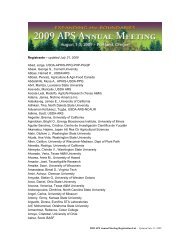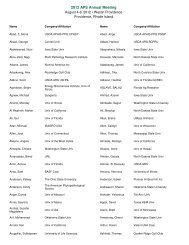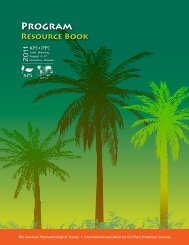view article - American Phytopathological Society
view article - American Phytopathological Society
view article - American Phytopathological Society
You also want an ePaper? Increase the reach of your titles
YUMPU automatically turns print PDFs into web optimized ePapers that Google loves.
oriented trajectories, with the receptor point located in the mountains of North Winter oilseed rape (Brassica napus) grown on 17'000 ha is<br />
Carolina, were calculated for April through August and for the annual period. the predominant edible-oil crop in Switzerland. The moat<br />
The 12-, 24-, and 48-hr air parcel positions prior to arrival at the receptor point important fungal diseases are caused by Phoma lingam, Alterwere<br />
analyzed by examining the plots of the probability density function (pdf). naria sp., Botrytis cinerea and Sclerotinia sclerotiorum.<br />
By integrating the pdf over a region of interest the probability that the given Cylindrosporium concentricum, Verticillium dahliae and Pseureceptor<br />
site will receive air parcels from this region can be obtained. Results docercosporella capsellae are rarely found but have the<br />
indicate that the probability of the receptor point receiving air parcels from the potential to become more prevalent.<br />
tobacco producing region of south Georgia/north Florida, which is a potential Integrated crop management is employed to try to control<br />
inoculum source region, increases during the April to August period. This these diseases. It involves measures such as use of resistant<br />
increase can be attributed to the strengthening of the Bermuda high pressure cultivars, crop rotation and removal of infected residue.<br />
system. Fungicides are considered a last resort. None are registered<br />
at present. The identification of resistant cultivars is a<br />
top priority in our research. Special nurseries have been<br />
established. The potential use of biotechnology for this<br />
7 purpose will be investigated.<br />
GENETIC DIVERSITY AND POPULATION STRUCTURE OF THE RICE<br />
BACTERIAL BLIGHT PATHOGEN. J. Leach, M. Rhoads, C. Vera Cruzi,<br />
F. White, T. Mews, and H. Leung . Dept. of Plant Pathology, 11<br />
Kansas State University, Manhattan, Kansas and lInternational INFECTION OF STRAWBERRY ROOTS BY COLLETOTRICHUM<br />
Rice Research Institute, Los Bafios, Philippines. FRAGARIAE AND GLOMERELLA CINGULATA. C. M. Howard, C.<br />
A repetitive DNA element pJEL101 isolated from Xanthomonas K. Chandler, and E. E.. Albregts. Univ. of Fla., AREC,<br />
campestris pv. oryzae (Xco) was used to determine the popula- Dover, FL 33527.<br />
tion structure of Xco in the Philippines. pJELl01, when used Large roots ca 14 cm long were excised from rhizomes<br />
to probe EcoRl-digested genomic DNA of Xco isolates, revealed of strawberry plants that had wilted in Florida<br />
race-specific restriction fragment length polymorphisms (RFLP). fruiting rields because of anhthacnose crown rot.<br />
Of 94 isolates examined, 26 RFLP types were identified. Most Isolations from the thizomes yielded primarily C.<br />
of the variability (20 RFLP types) was found in race 1, 2, and fragariae from seedlings that previously had bean<br />
3, which were isolated from lowland areas. Three RFLP types grown n a Florida nursery and G. cingulata ( = C.<br />
were found among isolates from traditional cultivars grown at gloeosoorioides) from Chandlec p-ans that previoaly<br />
high elevation. The genetic diversity of the total Xco popula- had been grown in a Tennesse.e nursery. The roots were<br />
tion was 0.93, of which 44% was due to genetic differentiation cut into 1 c.m sections and every other, section<br />
between races. The genetic diversities of isolates collected beginning with the basal section was plateC on PDA.<br />
in 1972-1976, 1977-1981, and 1982-1986, were 0.89, 0.89, and Colletotrichum spp. or G. cingulzta (primarily C.<br />
0.91, respectively, suggesting a consistently high level of fragariae fros seedlingY, and . cinngulata and C.<br />
variability in the pathogen population over the past 15 years. acutatum from Chandler) were isolated from 45% of the<br />
basal root sect ions and from 11% of 'he thi]cd<br />
sections. These fungi were isolated from 1.4% to 2.&%<br />
8 of sections 5, 7, 9, 11, and 13.<br />
CULTURAL CONTROL OF SCLEROTINIA CROWN AND STEM ROT IN<br />
ALFALFA SEED FIELDS. R, G, Gilbert, USDA-Agricultural 2<br />
Research Service, P. 0. Box 30, Prosser, WA 99350.<br />
Cultural control of Sclerotinia in broadcast-planted alfalfa A 72KD PROTEIN ASSOCIATED WITH CERCOSPORIN SYNTHESIS IN<br />
seed fields were: 1) "fall-burn" of harvest residue; 2)<br />
"winter-burn"; and 3) "spring-beat-back." Fall-burn reduced<br />
CERCOSPORA KIKUCHII TOXIGENIC ISOLATE PR. Jeffery A. Rollins<br />
and Robert C. Upchurch. Department of Plant Pathology, N.C.<br />
sclerotia in the field by >95%. Sclerotia were killed in State University, Raleigh, NC 27695-7616.<br />
the residue and surface soil. Only 14% of the surface soil<br />
sclerotia were viable after the fall-burn in November and Comparative SDS-PAGE analysis of the protein extracts of C.<br />
during the next 6 months the number of surface soil kikuchii parental isolate PR and cercosporin-minus mutants<br />
sclerotia declined from 246/m2 to 7/mi, and the viability of derived by UV mutagenesis from this isolate revealed that a<br />
sclerotia was reduced from 12 to 0%. Winter-burn reduced prominent 72kD protein present in the parental isolate was<br />
surface residue and sclerotia numbers, but did not reduce absent in the mutants. Two-dimensional gel electrophoresis<br />
viability and survival of surface soil sclerotia. Spring- indicates that the protein is basic. Gel scans indicate that<br />
beat-back dried the soil surface and reduced the canopy the protein composes as much as 12% of the total extractable<br />
relative humidity, which established conditions that were protein of PR, but that it is present in lower concentration in<br />
unfavorable for Sclerotinia activity. Alfalfa seed yields other Cercospora species. Temporal analysis of toxin and<br />
in the fall-burn and spring-beat-back treatments were 862 protein synthesis in PR shows that the 72kD protein is<br />
and 716 Kg/ha for an increase of 43 and 13%, respectively, positively correlated with the synthesis of cercosporin. We are<br />
over winter-burn, interested in identifying this protein by cloning and<br />
characterizing its encoding gene because of the possibility of<br />
its involvement in cercosporin synthesis and/or regulation.<br />
9<br />
CONTROL OF PHYTOPHTHORA ROOT ROT ON CITRUS WITH SODIUM<br />
TETRATHIOCARBONATE. N.E. Natheron and J.C. Natej ka,<br />
1<br />
Univrsiy ofArionaYum Agrc. ente, Yma, Z 8364CHARACTERIZATION OF HYDROXAMATE SIDEROPHORES AND SIDEROPHORE-<br />
Greenhouse studies were initiated to determine the efficacy of -MEDIATED IRON IN GAUMANNOMYCES GRAMINIS VAR TRITICI. S. DoniI,<br />
sodium tetrathiocarbonate (STTC) for control of root rot on S. Solel 3 , Y. Kashman 2 and I. BarashI, Dept. of 3 plant Pathology,<br />
citrus caused by Phytophthora citrophthora and _P. parasitica.<br />
When roots of rough lemon seedlings were inoculated with<br />
ARO, The Volcani Center, Israel.<br />
zoospores of these two fungi in the presence of STTC at 245<br />
pg/al or metalaxyl at 10 pg/al, resultant fresh weights of<br />
Under iron-deficient conditions Gaumannomyces graminis var<br />
tritici (Ggt) produces hydroxamate siderophores designated as<br />
shoots and roots did not differ from noninoculated plants, A, B and C according to their electrophoretic mobility. Siderowhereas<br />
inoculated plants without chemical treatment suffered phores B and C were identified as dimerum acid and coprogen B<br />
significant loss of shoot and root weights. Treatment with STTC<br />
at 4900 pg/al was necessary to inactivate propagules of<br />
respectively. Siderophore A exhibited and identical NMR spectra<br />
to dimerum acid but was chromatographically distinct. The system<br />
P. parasitica in naturally infested soil. Rough lemon seedlings of siderophores mediating uptake of iron was characterized. It<br />
planted 7 days after treatment of soil to avoid phytotoxic exhibited an active transport and Michaelis kineties. Ggt could<br />
levels of STTC had root and shoot weights equivalent to those utilize iron effectively from siderophores produced by other<br />
grown in soil treated with 10 pg/ml metalaxyl. Apparently,<br />
can reduce the severity of root rot on citrus caused by<br />
STTC fungi. Competition experiments between coprogen B., dimerum<br />
acid and hydroxamate siderophores from other structural classes<br />
P. citrophthora and _P. parasitica, suggest a common transport system. Wheat seedlings were capable<br />
of utilizing iron from coprogen B and dimerum acid. The role of<br />
siderophores in survival and virulence of Ggt will be discussed.<br />
10<br />
CONTROL OF FUNGAL DISEASES OF WINTE OILSEED RAPE IN SWITZER-<br />
LAND. M. W. Andrea and W. E. Winter, Swiss Federal Research Highly virulent isolates of Fusarium selani from soybeans produce the Nectria ascoma<br />
Station for Agronomy, Reckenholzstr. 191, 80146 Zuerich, stage. T. S. Abney, T. L. Richards, A. J. Ivanovich, & D. H. Scott. USDA-ARS and<br />
Switzerland. Purdue University, W. Lafayette, IN 47907.<br />
1136 PHYTOPATHOLOGY<br />
14



